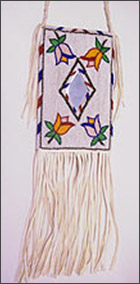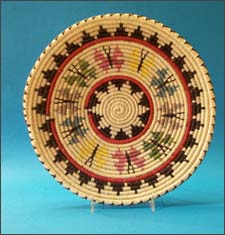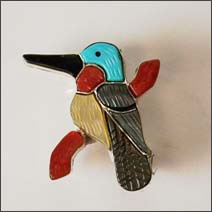Home
About Us
Current News
Event Calendar
Artist Bios
ARCHIVES
Display IDEAS
Collecting Tips
Gen Arts/Crafts Info
Testimonials
Hours/Directions
Online Store
POLLINATORS in AMERICAN INDIAN ART ... 2015
The Highlight of the Month program at The Indian Craft Shop focuses on a particular craft area, region or artist family/group. Our aim is to illustrate the diversity of tribal groups and the wide variety of artistic expressions and traditions in the country today.
Celebrating National Pollinator Week Each Year
| “Bees and Apple Blossoms” by Mark Seetin One of the wonders of natur eis the relationship between bees and apple blossoms.In the Spring,bees need the apple blossom for food, and in theFall, the blossoms that they pollinate have become apples - food for us. |
| ................................................................................................................... |
| Listen as Susan Pourian, Director of The Indian Craft Shop, discusses Pollinators in American Indian Art with host Harlan McKosato on the syndicated radio talk show Native America Calling. The live interview aired on June 2, 2009. |
 Each year The Indian Craft Shop gathers many arts and crafts in recognition of National Pollinator Week, which was established in order to build an awareness of the importance of pollinators and to teach pollinator-friendly practices.
Each year The Indian Craft Shop gathers many arts and crafts in recognition of National Pollinator Week, which was established in order to build an awareness of the importance of pollinators and to teach pollinator-friendly practices.
Pollination occurs when pollen is moved within a flower or carried from flower to flower leading to fertilization and seed and fruit production for plants. Pollinators help produce 70 - 80 percent of flowering plants and one third of human food crops.
American Indian art often depicts elements of our living world. Representations of animals and plants may symbolize an important role they play or the honor in which they are held by a tribe. Pollinators themselves – bees, butterflies, bats, hummingbirds, beetles, or rodents – appear in some pieces. The plants that they pollinate – yucca, devil’s claw, sumac or willow -- are used to make baskets and other kinds of utilitarian and art objects. Plants that are pollinated – watermelons, sunflowers, strawberries, squash, saguaro and more – are depicted in many different art forms.
 Butterflies are a common pollinator seen in Native American art. With their delicate beauty and strong flying ability, monarch butterflies migrate from the northern United States and Canada to central Mexico and back again, and are often prominent figures in Native American culture. For example, the Hopi, who have three different butterfly kachinas, depict butterflies in pottery, jewelry, carvings and basketry. Young women traditionally wear their hair in large whorls that resemble butterfly wings and there is a Butterfly Clan of the Hopi. The Zuni see butterflies as a symbol of the abundance of plants and flowers found in the summer, and portray them in jewelry and fetish carvings. Navajo concho belts often have a smaller butterfly shaped concho. Butterfly themes are also seen in beadwork, on baskets, in jewelry and on pottery from all over the country.
Butterflies are a common pollinator seen in Native American art. With their delicate beauty and strong flying ability, monarch butterflies migrate from the northern United States and Canada to central Mexico and back again, and are often prominent figures in Native American culture. For example, the Hopi, who have three different butterfly kachinas, depict butterflies in pottery, jewelry, carvings and basketry. Young women traditionally wear their hair in large whorls that resemble butterfly wings and there is a Butterfly Clan of the Hopi. The Zuni see butterflies as a symbol of the abundance of plants and flowers found in the summer, and portray them in jewelry and fetish carvings. Navajo concho belts often have a smaller butterfly shaped concho. Butterfly themes are also seen in beadwork, on baskets, in jewelry and on pottery from all over the country.
 Hummingbirds are another pollinator seen often in Native American art and folklore. Found only in the Western Hemisphere, these tiny birds enchant us with their iridescent beauty and nimble flight. They are often seen as messengers between the spirit world and this world, or as a creature that intervenes on behalf of humans. The Cherokee have a story about a medicine man who turned himself into a hummingbird to retrieve lost tobacco plants, while the Hopi have one about a toy hummingbird that came to life and brought an ear of corn every day to some children during a drought. Today these charming creatures of flight are seen in jewelry, fetish carvings, pottery and kachina dolls among other arts.
Hummingbirds are another pollinator seen often in Native American art and folklore. Found only in the Western Hemisphere, these tiny birds enchant us with their iridescent beauty and nimble flight. They are often seen as messengers between the spirit world and this world, or as a creature that intervenes on behalf of humans. The Cherokee have a story about a medicine man who turned himself into a hummingbird to retrieve lost tobacco plants, while the Hopi have one about a toy hummingbird that came to life and brought an ear of corn every day to some children during a drought. Today these charming creatures of flight are seen in jewelry, fetish carvings, pottery and kachina dolls among other arts.
Other pollinators appear in traditional tales and in art today. Bees are seen in jewelry and fetish carvings. The Hopi sometimes make pottery with a moth design, and have bee and wasp kachinas. Rodents such as mice, squirrels and rabbits, as well as bats, are also carved by Zuni fetish carvers. The Hopi have a famous story about the Warrior Mouse who defended his village from a marauding hawk, and carve kachina dolls in his honor.
Plants that are pollinated by animals or insects are used by Native Americans to create both utilitarian and artistic pieces. The Tohono O’odham use yucca (pollinated by moths) and devil’s claw (pollinated by wasps) for their basketry. The saguaro (pollinated by bats, bees and doves) used for their famous wine, is often depicted in basketry. The Navajo weave their baskets out of sumac (pollinated by bees). Willow, an important source of pollen and nectar for bees in early spring, is another material common in basket making. Gourds (pollinated by bees and beetles) are used for making rattles and decorative pieces. Sheep eat clover that relies on pollinators and the sheep’s wool is used for weaving rugs and clothing in the Southwest. Buffalo and deer eat berries that rely on bees, and their hides are used for clothing and accessories, as well as for parfleche.
Plants that are pollinated are often depicted in American Indian art. Squash blossom necklaces feature either squash or pomegranate flowers. Koshares holding or eating watermelons are found in jewelry, pottery and kachina dolls from the Pueblos. Flowers are created in jewelry, on pottery and baskets and in beadwork. In the Northeast, strawberry and blueberry baskets are made out of split ash and sweetgrass.
American Indian arts honor many elements of the living world, capturing their beauty and significance in many art forms. We hope you enjoy “Pollinators in American Indian Art.”
© The Indian Craft Shop, 2009
To see our current work, visit our online store at www.indiancraftshopsales.com
To learn more about the importance of pollinators and more about National Pollinator Week, go to www.fws.gov/savethemonarch ; www.fws.gov/pollinators and www.pollinator.org


